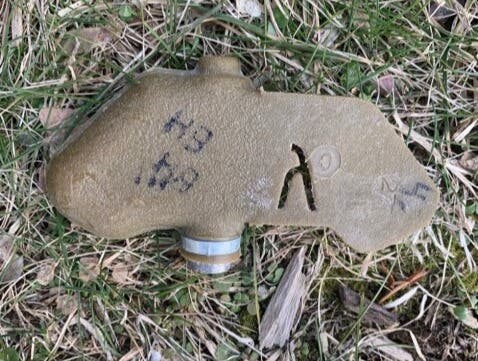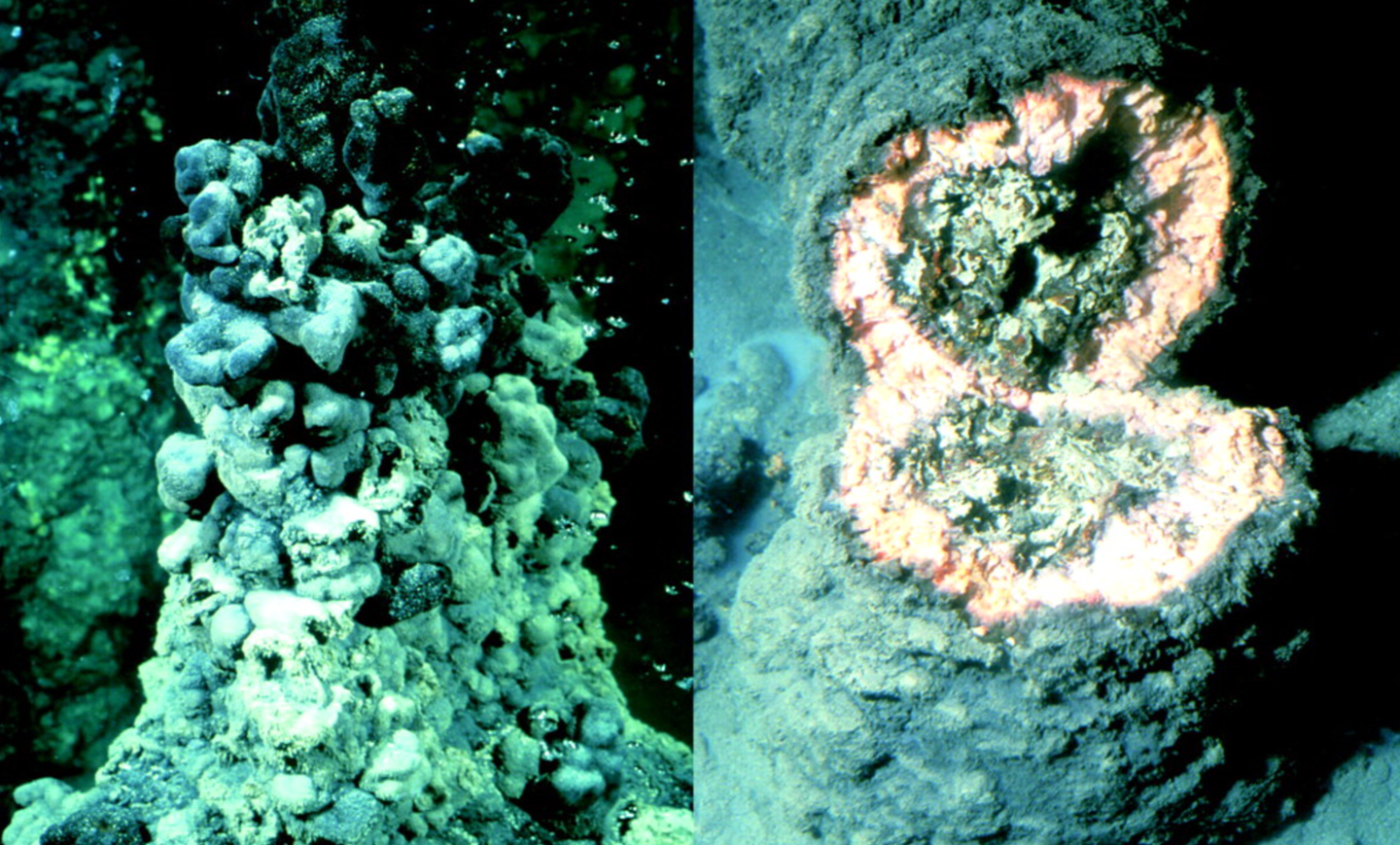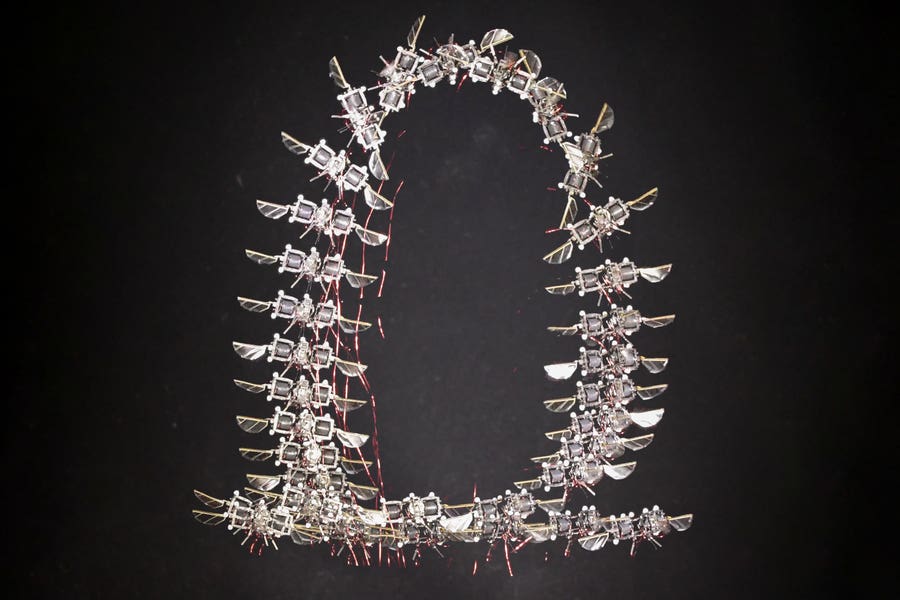Scientists are using drones and artificial intelligence to root out land mines
Baur and colleagues are trying to show that drone-born geophysical sensors may be applied to more efficiently spot and eliminate mines.

[Sept 21, 2021: Kevin Krajick, Earth Institute at Columbia University]
A Russian-made PFM-1 land mine. Dropped from the air in large batches, the mostly plastic devices are filled with explosive liquid. Many children, thinking they are toys, have picked them up and been killed or maimed. (Credit: Jasper Baur)
Armed with a newly minted undergraduate degree in geology, Jasper Baur is in the mining business. Not those mines where we extract metals or minerals; the kind that kill and maim thousands of people every year. Baur and colleagues are trying to show that drone-born geophysical sensors already used in fields such as exploration geology, volcanology and archaeology may be applied to more efficiently spot and eliminate these deadly hazards.
As a freshman at upstate New York's Binghamton University in 2016, Baur started working with two geophysics professors, Alex Nikulin and Timothy de Smet, to look into employing instrument-equipped drones to speed the slow, hazardous task of finding land mines. Baur stuck with the research all the way through college; now a grad student in volcanology at Columbia University's Lamont-Doherty Earth Observatory, he is still pursuing it.
"It seemed like a really relevant and impactful use of science," he said. "It has a humanitarian aspect, and that's definitely what motivates me in my research."
Mines and other unexploded ordinance are a worldwide menace; about 100 million devices are thought to be currently scattered across dozens of countries. Aside from putting both wartime and postwar areas off limits to travel, agriculture or anything else, they caused at least 5,500 recorded casualties in 2019; totals in many previous years have been much higher. Some 80 percent of the victims are civilians, and of those, nearly half are children. Over the last decade, mines have been deployed in at least 15 countries: Afghanistan, Colombia, India, Iran, Israel, Libya, Myanmar, Nigeria, North Korea, Pakistan, Syria, Thailand, Tunisia, Ukraine and Yemen. This, despite the fact that more than 160 nations have signed a 1997 convention to bar their stockpiling or use (major exceptions: the United States, Russia and China).
Those who lay mines rarely come back to clear them. That generally falls to nonprofit humanitarian organizations, who mostly find them the old-fashioned way: on foot, slowly sweeping suspect sites with magnetometers or other handheld instruments. Finding and disarming a single mine takes plenty of time, and costs an estimated $300 to $1,000. "And, of course, it's dangerous," notes Baur.
Enter increasingly affordable and sophisticated drones and miniaturized geophysical sensors. The Binghamton team's first focus: the Russian-made PFM-1 mine, a device just five inches across, made largely of plastic, and shaped like a butterfly. Designed to be dropped from the air in large numbers, they flutter gently to the ground like flocks of birds, and await the unwary. Designed mainly to maim, not kill, they are difficult to spot with a magnetometer, because they contain little metal. And because they resemble plastic toys, many children handle them, and get blown up. They remain in the arsenals of various countries, but Afghanistan is ground zero for them. An estimated 10 million may still litter the country—many not even from recent fighting, but from the Russian occupation of 1979-1989. They have killed or injured more than 30,000 Afghans. More recently, they have shown up along Ukraine's violently contested border with Russia.
To carry out experiments, the team bought a few dozen PFM-1s off a military collectibles site—disarmed of course, their explosive liquid interiors drained and refilled with an inert oil. They scattered the mines in a variety of landscapes on campus and at nearby Chenango Valley State Park, including grass, sand and snowy ground. Then they sent drones up to explore various ways of spotting them, visually or otherwise. To simulate the rubbly high-mountain Afghan terrain where the mines are most often found, they got permission from the state park to mine an abandoned, partly broken-up old asphalt parking lot.
One fruitful avenue, they found, was thermal imaging; in early morning and at the end of the day, the mines heat up or cool off at different rates than surrounding material. In early trials, they demonstrated that they could find about three-quarters of PFM-1s by manually observing temperature differences on a computer. They also tried out visible and infrared light spectra to spot the mines visually, with similar success. The team admits this is not good enough for drones to replace ground teams, but it could quickly narrow down locations and layouts of mine fields. (Flying at 10 meters above the surface, a drone can survey a 10-by-20-meter plot, the typical size of a single ellipsoidal PFM-1 mine field, in three and half minutes.)
More recently, in order to improve the detection rate, the team has started employing machine learning, training their computers to recognize various mine characteristics and quickly display them. In a paper just published in the Journal of Conventional Weapons Destruction led by Baur and former fellow student Gabriel Steinberg, they show how artificial intelligence has allowed them to increase the visual detection rate to more than 90 percent.
The group has also looked into spotting traditional buried metal mines, showing that drones bearing aeromagnetic instruments can see some of these too, including big antitank mines. (Like many other munitions, these also are available on military surplus sites, disarmed.) They are also investigating how to find unexploded ordinance fired from multi-barrel rocket launchers.
Now that he is pursuing volcanology, Baur may not have as much time for demining. Working under Lamont-Doherty volcanologist Einat Lev, this summer he traveled to Okmok Volcano, in Alaska's remote Aleutian Islands. There, he worked on a project to install geophysical instruments on the highly active peak to measure changes in ground level, seismic waves and other properties, part of a broad, long-term effort at Lamont to refine the still crude science of predicting dangerous eruptions.
What does volcanology have to do with land mines? Nothing, he says—and everything. Some instruments and data analysis techniques useful in studying volcanoes are similar to those useful for detecting mines. And, increasingly, volcanologists are deploying drones to survey places too hazardous to go on foot. Applied volcanology, too, is like demining in that it is ultimately aimed at helping people avoid injury or death.
In the meantime, Baur has formed an organization, the Demining Research Community, with his old professors and Steinberg. They have been in contact with, among others, demining professionals at the Red Cross and the United Nations. Various organizations have already considered using drones to speed their work, but so far there has been little other published research, and no uptake. "For very good reasons, the demining community is very cautious. They're reluctant to accept new methods," said Baur. "So you really have to establish that this works, and that is going to take time."
So far, Baur has glimpsed only one actual mine field, a marked one, during a visit to Israel. Eventually, he says, "we want to test our methods on a real mine field. You can't account for everything you might run across in an artificial environment. There's a lot more chaos in the real world."
Now that the Taliban has taken over Afghanistan, would he consider going there to do his real-world research? "Uh, no." But there is always Ukraine. "We have some contacts there," he said.
Like these kind of feel good stories? Get the Brighter Side of News' newsletter.
Tags: #New_Innovations, #Robotics, #Drones, #AI, #The_Brighter_Side_of_News



